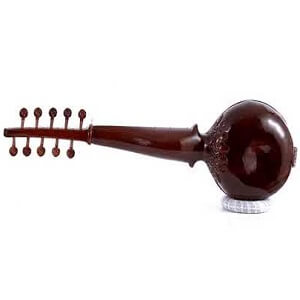Sursingar
 Sursringar (sursingar) is an old instrument which today is very rare. It may be visualised as being a cross between a sarod and a sitar. Sursringar is played in the dhrupad styles. Its voice is deep and somber and evokes an ethos of a bygone era.
Sursringar (sursingar) is an old instrument which today is very rare. It may be visualised as being a cross between a sarod and a sitar. Sursringar is played in the dhrupad styles. Its voice is deep and somber and evokes an ethos of a bygone era.
The origin of the instrument is obscure, but E.S. Perera in his “Origin and Development of Dhrupad and its Bearing on Instrumental Music” relates an interesting legend. According to the story, it was in the early to mid 19th century in the court of Raja Udit Narayan Singh of Benares, that there happened to be a music competition. The two major contestants were the great Nirmal Shah on the rudra vina and Zaffar Khan on the Seni rabab. The king ordered the two contestants to play Mian-ki-Malhar. Jaffar Khan was concerned, because it was the middle of the monsoon time and the inclemate conditions had rendered his rabab unplayable. Jaffar requested and was granted one months leave. But rather than take a chance on the wether improving, Zaffar Khan addressed all of the elements of the rebab that were sensitive to moisture. He replaced the wooden finger board with metal. The skin was replaced with a wooden face, and the gut strings were replaced with metal. In this manner he invented the sursringar which effectively was a seni rabab that was impervious to humidity. He returned to the competition with the new instrument, played it, and was declared to be the winner.
There are two ways to play the sursringar. In the old days it was held almost vertically with the neck over the left shoulder (Do not be confused by the photo at the top of the page. This photo is of the late Allauddin Khan who was well known for his left handed sarod technique.)